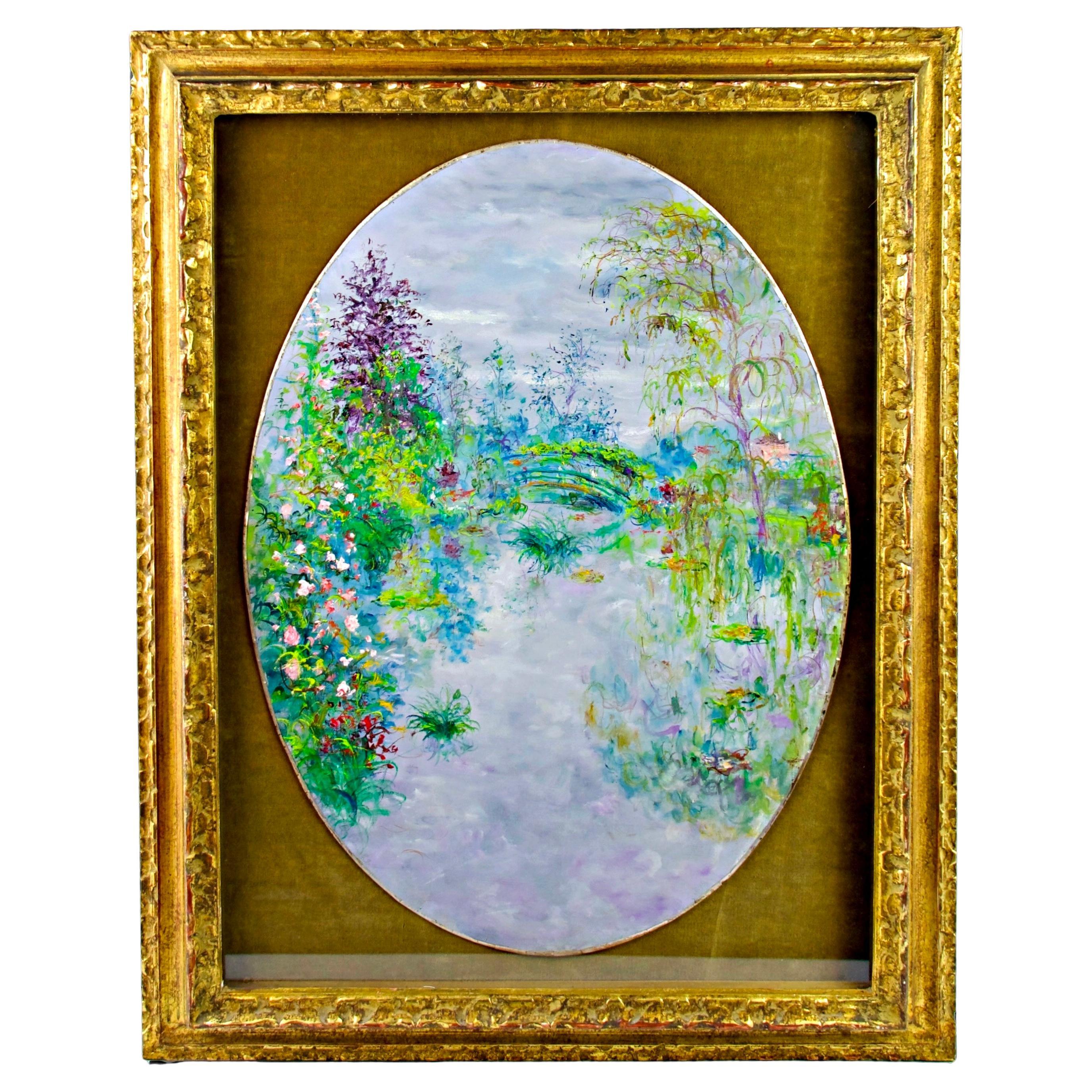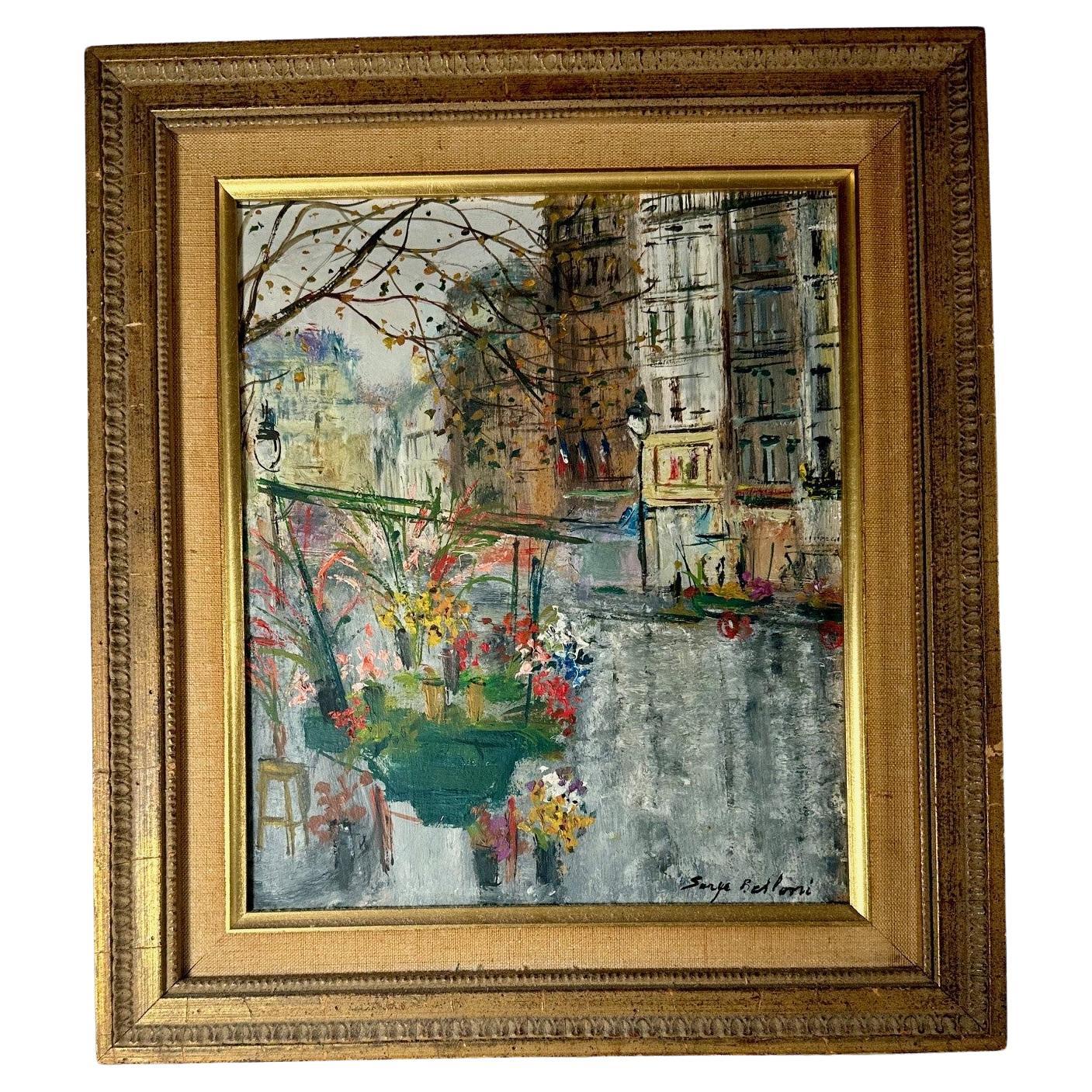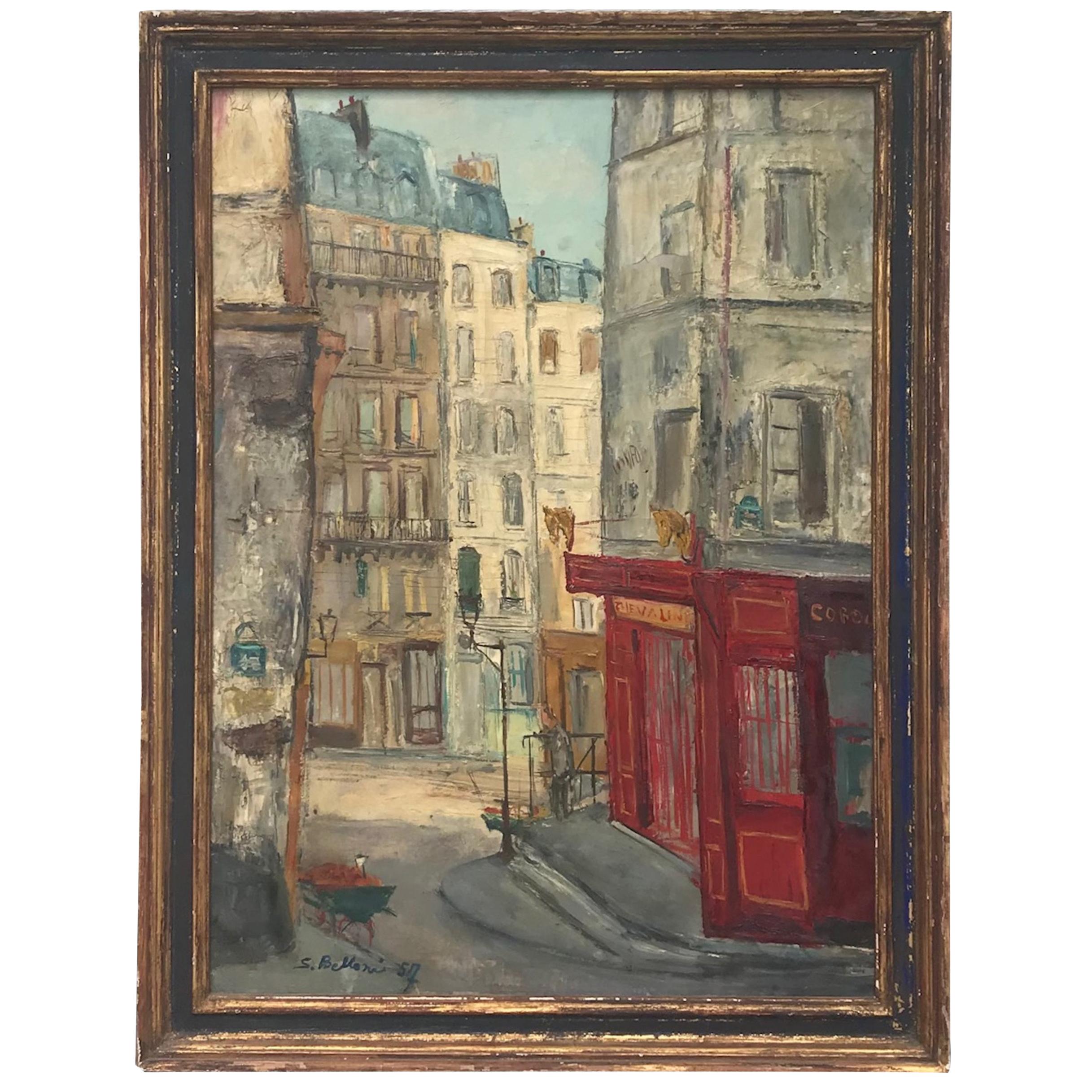Items Similar to Serge Belloni, The Rose Bouquet, France, 1980s
Want more images or videos?
Request additional images or videos from the seller
1 of 7
Serge Belloni, The Rose Bouquet, France, 1980s
About the Item
Beautiful painting of a bouquet of a bouquet of roses in a vase, by the artist Serge Belloni (1925-2005). Framed under glass. Frame gilt gold. Signed "Serge Belloni".
In good condition. Slight signs of use on the gold frame.
Dimensions in cm of the piece (H x L) : 27 x 22
Dimensions in cm of the frame (H x L) : 46,5 x 41
Secure shipping.
Serge Belloni, born in Piacenza on February 25, 1925 and died in Menton on October 28, 2005, is a French painter of Italian origin.
Serge Belloni, known as The Painter of Paris, is the son of the upholsterer Luigi Belloni and Elvira Belloni born Molinari. He arrived in Paris in 1933 where he studied painting at the École nationale supérieure des beaux-arts de Paris. He exhibited his paintings from 19463.
Several of his works are kept by the Carnavalet Museum in Paris.
He is buried in the Père-Lachaise cemetery (12th division).
(Wikipedia)
The dawn, to him, seems to linger, the day seems to have difficulty to rise. He contemplates and loves this birth at the same time beautiful and painful. His head is heavy because he has slept badly: so many projects are jostling in his mind, so many desires, to the point of vertigo, to undertake and complete landscapes and compositions.
It is autumn. Autumn in Paris in this light with iridescent colors where the purples and the bluish greys dominate, which agree so well with the poetry of Verlaine and Rimbaud which sings in his heart.
The light of day rises. It is necessary to attack. A daily sport session so that "brother the body" is up to what will be asked of him throughout the hours that will follow; a cup of strong Italian coffee quickly swallowed and he runs to his appointment with the motif. He runs there with the same lively joy as forty years earlier, with the same love in his heart but also with the same anguish: will he be up to the task?
The memory of the lessons of the Ancients, of what they were, weighs heavily on him.
Paris! The city sticks to his skin. Like all love, attraction of the heart as well as of the spirit, call of the flesh, it is inexplicable. This city where the windows are as many eyes looking at you. Does he choose his subject? He is sure of the contrary: it is the subject who chose him and asks him to paint his portrait. Because what he wants to paint, what he paints, are portraits of Paris. Paris and its moods. Its joys. Its sorrows. Its melancholy. "The cries of Paris" to use Paul Fort's expression.
Here he is on the ground. He makes sketches, preparatory drawings. In fact he marries his subject, becomes his subject that he could draw from memory. Then he attacks a small canvas that he works at length, riveted to the motif. He does not draw on the canvas because charcoal would dirty the color and the pencil would risk casting a shadow under it. He sketches the subject by covering the canvas completely. From then on, he held on to his guiding thread which, from the small canvas, would lead him to larger formats, even if he changed his technique to better render the emotion: egg tempera then oil or directly oil colors.
He uses a very fine-grained canvas and "sable" brushes that give him the feeling of lovingly caressing his canvas, his subject.
He is alone on this bridge, on this quay, at the top of this terrace. Alone in the cold that penetrates him to the bone, under the rain that streams down his face, his hands, flows down his neck and slides on his canvas. Alone in front of this high sun whose rays dart hard. The motif, nothing but the motif: no canvas is finished or retouched in the studio. His studio is the open air. To paint on the ground, it is to find the truth and to feel an emotion which will translate its tables. An unwavering requirement that had struck Francis Carco writing: "I think it is difficult to be more in love with his art than him and more demanding. How many painters of this quality would be able to devote up to forty sessions to the same motif? His greys and blues are inimitable and, why hide it, his love of Paris made him paint his best canvases.
His first paintings were dark. It is true that at the time Paris was emerging from the war and the last renovations were far away. Perhaps these muted and dark colors also expressed a certain melancholy? Over the years, he moved towards the light. Did his travels in the East, the oriental philosophy, open other horizons to him? It is possible. On the other hand, it is certain that the influence of those who have always encouraged his work has played a role in the evolution of his palette: Carco, Dorgelès, Paul Fort, Pierre Brisson, Jean Griot who wrote: "If I tried to define the nature and the quality of the dialogue that exists between Serge Belloni and those who love and admire his work, I would say that this dialogue is of a poetic nature.
Poetry is a song. To make his canvas sing: that is his concern and his exaltation. The canvas must vibrate, sing. A single false note and everything falls apart: the chords no longer ring true, the architecture of the painting collapses, colors, drawings, volumes pass by what should be harmonious and balanced.
Noon. He returned home and limited himself to a frugal meal. His friends tell him that he is neither gourmet nor gourmand, that he has no palate. He replies that the pleasures of the table are those that he gets from the friendship of his guests and that the deprivations he experienced during his teenage years, which were those of the war, have trained him to this Spartan diet. He turned his canvas against the wall: if he looked at it more doubt would invade him, would grow and would risk pushing him, at night, to destroy what he had done a few hours earlier.
In the afternoon, he leaves with another canvas: everything is changed because it is no longer the same light.
He loves Paris in autumn and winter: the trees stripped of their leaves show him its architecture and its soul. He likes to paint portraits and nudes, which remind him of his research when he was studying the anatomy of the body. He also paints flowers on a gold background, a technique he has been practicing for more than thirty years, constantly seeking to improve it.
Second pole of his activity: Venice, several months each year, in a total solitude that he considers essential to creation. His tastes lead him to Venice Minor, the most ancient, where he finds the audacity and strength of the first builders who gave the city its soul. The softness of the marble with a patina of time where the light plays, the harmony of the sky and the water, this permanent festive air give him a complete joy. He had the chance to discover Venice at a very young age with Professor Guido Perocco and his brother, who was the Magistrate of the Serenissima Waterworks.
Does this passion for Art devour him to the point of making him an egomaniac, an egoist? Isn't Art a kind of watering hole: the closer you get to it, the more it attracts you, him and him alone? The answer to these questions is simple: if he had to start from scratch and redo the path he had taken, he would not hesitate. And at this moment, his memory goes back to his friends of the past: Gérard Blondel who died too young, Lucien Philippe Moretti who became a great painter.
And yet, to start again would mean getting up very early, working hard to earn a living without ever making any concession to his artistic ideal; in the afternoon going to the Beaux-Arts, in the evening to the Academy, coming back exhausted but with dreams full of head in this tiny room where he spent his beautiful years of youth, without any possible distraction.
Yes, all this I will do again with the same love, the same perseverance.
As I talk to him, I look at him in the mirror: he is in front of me and I see him again at his first exhibition in Paris for his twentieth birthday and I think of the one at the Carnavalet Museum forty years later. Everest is not the only peak to reach.
He has light eyes and gray hair and I say to him: "Hello, Serge Belloni".
Serge Belloni
1986.
- Dimensions:Height: 18.31 in (46.5 cm)Width: 16.15 in (41 cm)Depth: 1.97 in (5 cm)
- Materials and Techniques:
- Place of Origin:
- Period:1980-1989
- Date of Manufacture:1980s
- Condition:
- Seller Location:PARIS, FR
- Reference Number:1stDibs: LU8131233358712
About the Seller
5.0
Vetted Seller
These experienced sellers undergo a comprehensive evaluation by our team of in-house experts.
Established in 2020
1stDibs seller since 2023
10 sales on 1stDibs
Typical response time: <1 hour
- ShippingRetrieving quote...Ships From: PARIS, France
- Return PolicyThis item cannot be returned.
More From This SellerView All
- Serge Belloni '1925-2005', the Japanese Bridge at Giverny, 1989Located in PARIS, FRSuperb and vivid painting of the Japanese bridge at Giverny, Claude Monet's (1883 - 1926) residence, by the artist Serge Belloni (1925-2005). Framed unde...Category
Vintage 1980s French Paintings
MaterialsWood, Paint, Fabric, Cut Glass
- Daum France, Carafe, 1980sBy DaumLocated in PARIS, FRBeautiful Daum France carafe. Handle in glass paste of green and yellow hues and decorations of foliage and berries. Body in Daum Crystal. Signed Daum Fr...Category
Vintage 1980s French Art Nouveau Pitchers
MaterialsCrystal
- Lalique France, "Finches" Bowl, 1980sBy LaliqueLocated in PARIS, FRBeautiful "Finches" model bowl by the Lalique France manufacture, France 1980s, signed and manufacture sticker. In excellent condition. Dimensions in cm ( H x D ) : 9.5 x 23.6 Se...Category
Vintage 1980s French Art Deco Serving Bowls
MaterialsCrystal
- Lalique, "Narcissus" Vase, France 1980sBy LaliqueLocated in PARIS, FRSuperb Narcissus vase by the Lalique Maison, France 1980s. Excellent condition, sold with a Lalique box. Dimensions in cm ( H x D ) : 26.5 x 20.3 Secure shipping.Category
Vintage 1980s French Mid-Century Modern Vases
MaterialsCrystal
- Daum France, Rose Carafe, France 1980By DaumLocated in PARIS, FRSuperb Daum France decanter with its beautiful stopper in glass paste in the shape of a rose. Signed Daum France, carafe engraved with the letters BR. In excellent condition. Dimen...Category
Vintage 1980s French Art Nouveau Crystal Serveware
MaterialsCrystal
- Lalique, "St-Hubert" Decanter, France 1980sBy LaliqueLocated in PARIS, FRBeautiful St-Hubert decanter by the Lalique Maison. Stopper with decorations of oak tree leaf. Signed Lalique France. In very good condition. Secure shipping. The Lalique Maison was created by René Lalique who was one of the greatest artists of his time, whether as a jeweler or master glassmaker. He marked the Art Nouveau and Art Deco periods with his unique style. Lalique is recognized as one of the most important jewelry designers and glass maker of the French Art Nouveau period, creating innovative pieces for Samuel Bing's new store in Paris, Maison de l'Art Nouveau. He began exhibiting his work under his own name as early as 1894, notably at the Salon des artistes français, 1897 and 1898. The great glassmaker Émile Gallé discovered him at the first one and praised him highly. His Stand at the 1900 Universal Exhibition in Paris was a great success. While keeping sources of inspiration from the Art Nouveau woman, fauna and flora - including the peacock, various insects and sometimes a fantastic bestiary - he innovated by using materials barely used for jewelry at the time: glass, enamel, leather, Horn, mother of pearl, often preferring semi-precious stones to precious stones. The introduction of volume in jewelry is facilitated by his knowledge in modeling. He designed his models, having them made by a team of chisellers, sculptors and enamellers that he carefully recruited. Many women from the nobility, the bourgeoisie and the entertainment world began to wear his extraordinary jewelry, such as the Marquise Arconati-Visconti, the Countess of Béarn, Madame Waldeck-Rousseau, and Sarah Bernhardt, for whom he created a stage costume in 1902 for the revival of the play Théodora at the Sarah-Bernhardt Theater. Lalique was the only modern artist whose client and friend Calouste Gulbenkian became. Gulbenkian acquired the famous Pectoral à la libellule (circa 1897-1898), a masterpiece much admired at the 1900 World's Fair, which he lent to the tragedienne Sarah Bernhardt. After the end of the First World War, Lalique's colorful and fantastic jewelry were no longer in fashion. The creator sensed this and decided to convert to the Art Deco style through glassware in 1920. Thus, the neo-classical and geometric Art Deco replaces Art Nouveau. According to Olivier Mauny, former CEO of Lalique, his creations paved the way for an industrialization of art objects, because one of the best ways to include luxury and aesthetics in everyday life is to make everyday objects. He will create many objects such as vases, cups, candlesticks, perfume bottles, radiator caps for the Citroën 5CV (1925), decorations for the restaurant cars of the Côte d'Azur Pullman Express (1929), decorations for the dining room of the first class of the Normandie liner...Category
Vintage 1980s French Art Deco Pitchers
MaterialsCrystal
You May Also Like
- Original Serge Belloni Parisian Cityscape. Signed Framed Autumn PaintingLocated in Vero Beach, FLOriginal Serge Belloni Parisian Cityscape. Signed Framed Autumn Painting on Board. Charming Parisian cityscape, signed and framed oil on artist board by Serge Belloni. The painting displays essential features of Belloni’s renowned Parisian works. This view of Paris features an autumnal scene with glassy architectural reflections. In the moody street scene sits a flower vendor’s cart...Category
Mid-20th Century French Other Paintings
MaterialsGiltwood, Paint
- Original Serge Belloni Parisian Cityscape Painting Seine River, Signed Framed.Located in Vero Beach, FLOriginal Serge Belloni Parisian Cityscape Painting. Signed Framed Seine in Autumn. Charming Parisian view of the Seine in Autumn, cityscape...Category
Mid-20th Century French Other Paintings
MaterialsGiltwood
- Parisian Cityscape, Signed and Framed Oil on Canvas by Serge BelloniLocated in Vero Beach, FLParisian cityscape, signed and framed oil on canvas by Serge Belloni, ‘57 This painting has all the quintessential features of Belloni’s renowned Parisi...Category
Vintage 1950s French Mid-Century Modern Paintings
MaterialsCanvas
- Bouquet of Roses on the TableBy Hermann EulerLocated in Alessandria, PiemonteO/5816 - Antique picture signed P. Euler (Pierre-Nicolas Euler - 1846-1913). French painter of flowers and fruits. He studied at the school of Fine Arts in Lyon from 1860 to 1865. H...Category
Early 20th Century German Beaux Arts Paintings
MaterialsCanvas
- Painting by Sergio BelloniLocated in Pomona, CAOil on board painting of the Italian Grand Canal by Sergio Belloni. Measurement without frame 15" W, 6.50"HCategory
Late 20th Century Paintings
MaterialsWood, Paint
- René Leroy, French Artist, Watercolor on Paper, 1980sLocated in Copenhagen, DKRené Leroy (b. 1931), French artist. Watercolor on paper. 1980s. Visible dimensions: 7.5 x 7.5 cm. Total dimensions: 18 x 18 cm. In excellent condition. Signed and dated.Category
Vintage 1980s French Modern Paintings
MaterialsPaper





